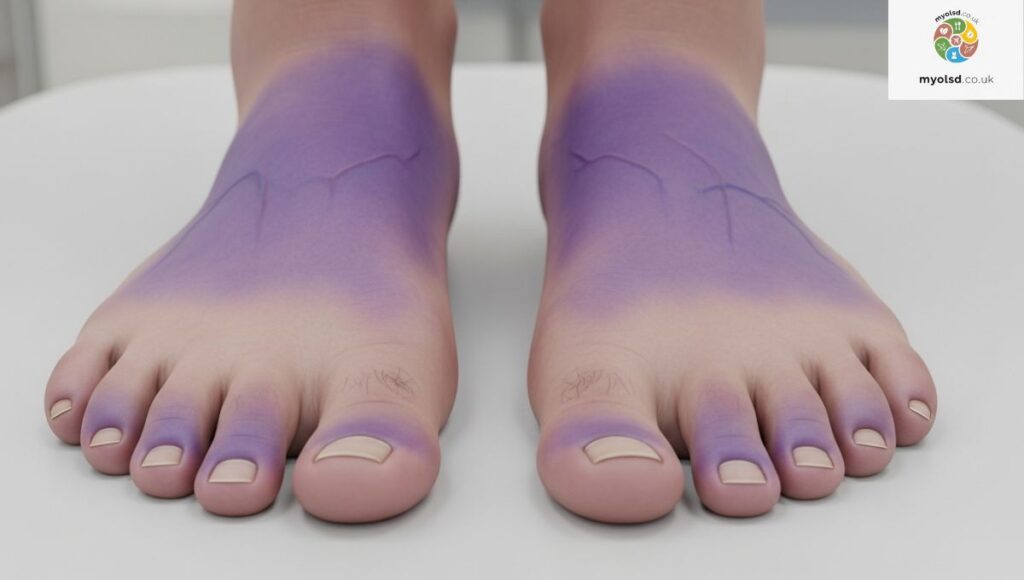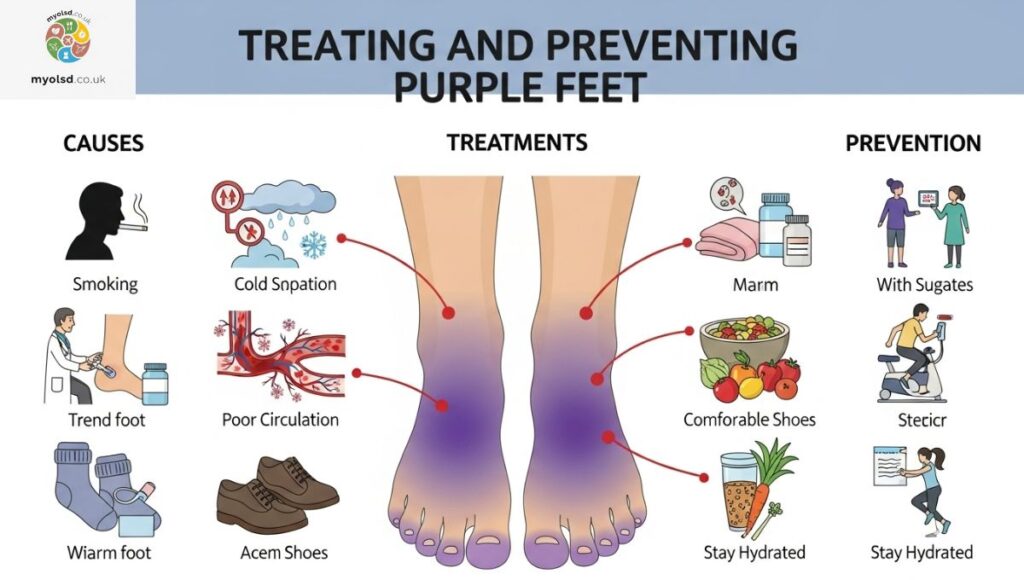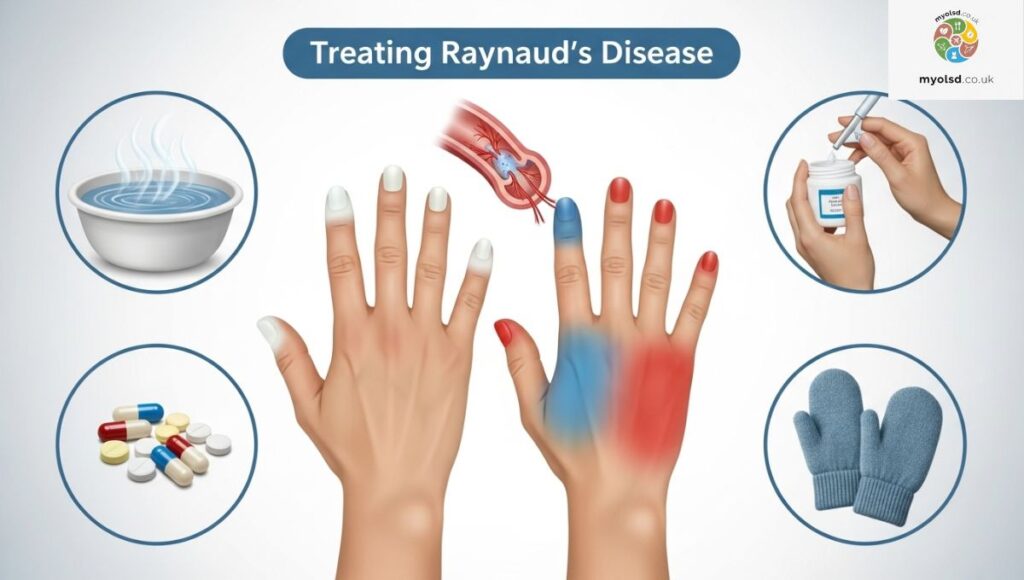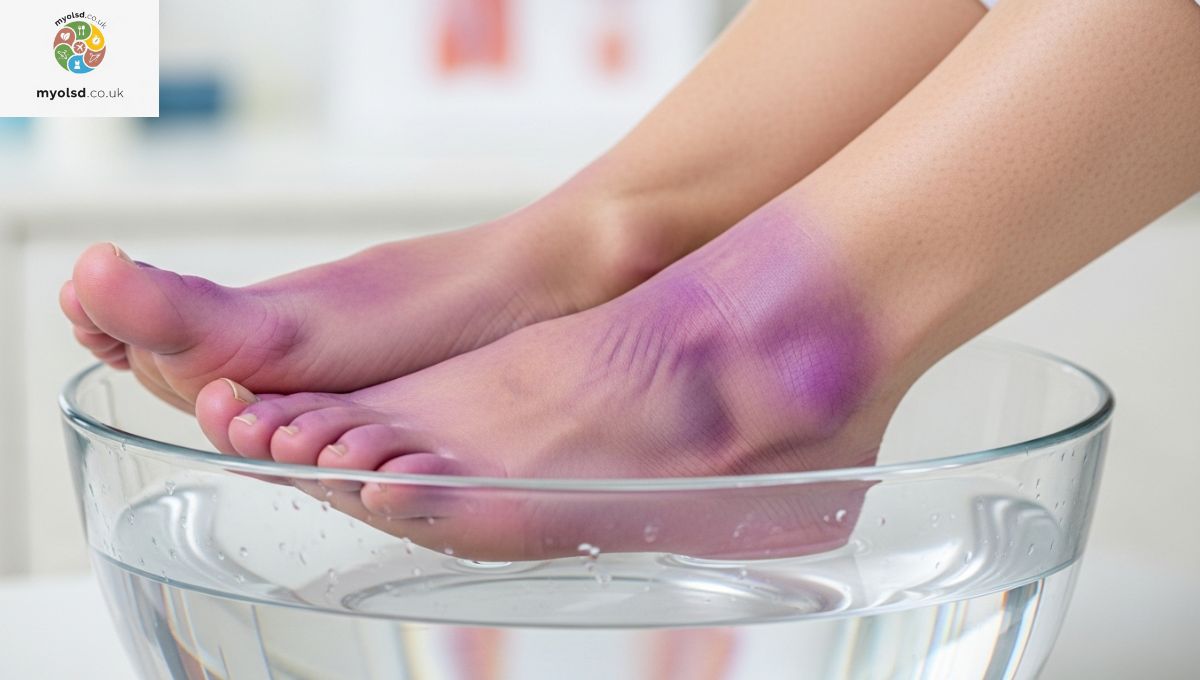Have you ever looked down at your feet and thought, Wait why are my feet purple? It can be a little scary and confusing, especially if it seems to happen out of nowhere. Many people worry when they notice their toes or feet changing color because it feels like a sign something might be wrong. You’re not alone this is a common concern that often sparks a quick search online.
In this blog post, we’ll break down the possible reasons why your feet may turn purple, from harmless causes like cold weather to medical issues that might need attention. You’ll learn what signs to watch for, when to relax, and when it’s time to see a doctor. By the end, you’ll have a clearer understanding of what’s happening with your feet and how to take care of them.
Causes of Purple Feet

Purple feet can occur for a variety of reasons, ranging from minor issues to more serious medical conditions. Understanding the causes helps you figure out whether it’s a temporary reaction or a sign to see your doctor.
Your feet are at the end of your circulatory system, meaning blood has to travel the farthest to reach them. When blood flow slows down or becomes restricted, oxygen levels in your tissues drop, creating a bluish or purple appearance a condition known as peripheral cyanosis.
Let’s look at some common causes:
Ischemic Foot
An ischemic foot occurs when blood flow to your lower limbs is severely reduced, often due to artery blockage or narrowing. This lack of oxygen-rich blood leads to purple discoloration, cold sensation, numbness, and sometimes pain while walking. People with high cholesterol, high blood pressure, smoking habits, or diabetes are at greater risk.
Without treatment, an ischemic foot can develop ulcers, tissue damage, or even increase the risk of amputation. Early recognition and medical evaluation are essential.
Acrocyanosis
This is a painless, persistent bluish or purple discoloration of the extremities, especially the feet and hands. It’s usually caused by blood vessels constricting due to cold weather or emotional stress. Unlike Raynaud’s disease, acrocyanosis doesn’t cause severe pain or skin ulcers.
Although generally harmless, it’s a sign of poor circulation at the surface of the skin. Wearing warm socks, avoiding extreme cold, and reducing stress triggers can help minimize the discoloration.
Raynaud’s Disease
Raynaud’s disease involves sudden arterial spasms in response to cold temperatures or stress, temporarily reducing blood supply to the extremities. Your toes may turn white, then blue or purple, before returning to normal color as blood flow resumes.
This condition can occur on its own (primary Raynaud’s) or alongside other health issues such as connective tissue diseases like scleroderma or lupus. People with Raynaud’s often benefit from wearing warm, protective footwear, managing stress, and sometimes taking vasodilator medications like calcium channel blockers.
Diabetes
Diabetes can damage blood vessels and nerves, leading to poor circulation, delayed healing, and a higher risk of foot ulcers. Diabetic neuropathy can cause tingling, pins and needles, or loss of sensation, making it harder to notice injuries.
Purple or bluish feet may signal blood pooling or a wound that’s not healing properly. Regular foot care, healthy diet, blood sugar management with medications such as metformin or insulin injections, and visits to a podiatrist can prevent complications.
Frostbite
Prolonged exposure to extreme cold can freeze the tissues in your feet, leading to frostbite. Early symptoms include pale skin, numbness, and a bluish discoloration that may turn purple or black if tissue damage worsens.
Prevent frostbite by wearing water-resistant boots, insulating socks, and avoiding extended time outdoors in severe cold. Seek immediate medical attention if frostbite is suspected to prevent tissue damage or amputation.
Treating and Preventing Purple Feet

Addressing purple feet starts with identifying the cause. Some cases are mild and temporary, while others require prompt medical care. Here’s how common conditions can be treated or managed.
Treating Ischemic Foot
Your doctor may recommend angioplasty, stent placement, or bypass surgery to restore blood flow to your foot. Lifestyle changes such as quitting smoking, following a heart-healthy diet, and exercising regularly improve vascular health.
Medications like cholesterol-lowering drugs, antiplatelets, and blood pressure medications can also help reduce further arterial narrowing.
Treating Acrocyanosis
Because acrocyanosis is usually harmless, treatment focuses on prevention. Keep your feet warm with layered socks, avoid sudden cold exposure, and gently massage your feet to improve blood flow.
If symptoms are persistent or severe, a healthcare provider may check for underlying autoimmune diseases or circulation issues.
Read more Article:Car Shakes When Accelerating?
Treating Raynaud’s Disease

Management of Raynaud’s involves avoiding cold weather exposure, reducing stress triggers, and maintaining a warm environment for your extremities. In some cases, vasodilators or calcium channel blockers are prescribed to relax blood vessels and improve circulation.
Lifestyle measures like regular exercise, limiting caffeine, and quitting smoking can reduce episodes and improve vascular health.
Treating Diabetes
Good blood sugar control is key to preventing foot discoloration and complications. This includes taking prescribed medications, eating a balanced diet, and checking your feet daily for injuries.
Use arch support insoles, wear properly fitted shoes, and consider warm foot baths to improve circulation. If wounds or rash patches appear, consult a podiatrist promptly.
Treating Frostbite
Mild frostbite may be managed at home with a warm bath treatment or gentle rewarming, but severe frostbite requires emergency care. Avoid rubbing the affected area, as it can worsen tissue damage.
Medical treatment may include pain management, antibiotics to prevent infection, and, in extreme cases, surgical removal of dead tissue.
Take It One Step at a Time

If your feet have turned purple, don’t panic but don’t ignore it either. Sometimes, it’s as simple as sitting cross-legged for too long or being out in cold weather. But if it happens frequently, without a clear cause, or along with other symptoms like pain, swelling ankles, or difficulty walking, it’s worth getting checked by a healthcare provider.
Your feet are vital to your mobility and overall cardiovascular health. Addressing discoloration early can help prevent long-term complications such as wound healing delays, foot ulcers, or even gangrene.
How We Reviewed This Article
This article was created using current medical references from vascular health specialists, diabetic foot care guidelines, and preventive cardiology research. It reflects evidence-based approaches to managing and preventing foot discoloration.
Get Our Free Heart-Healthy Recipes
Alongside taking care of your feet, supporting your heart and blood vessels with a healthy diet is crucial. Sign up for our free heart-healthy recipe guide to help lower cholesterol levels, manage blood pressure, and improve circulation naturally.
Was This Article Helpful?
Your feedback matters. If you found this article on why are my feet purple useful, share it with others who might benefit. Foot health is an important part of overall well-being don’t overlook it.
Additional Tips for Foot Health
- Stretch regularly: Moves like calf raises and runner’s stretches boost blood flow to your feet.
- Elevate your feet: This helps reduce swelling and improves circulation after long hours of standing.
- Wear the right shoes: Proper fit and support prevent foot injuries and discomfort.
- Check your skin: Look for color changes, sores, or shiny skin that might indicate poor circulation.
- Stay warm: Heated socks or foot warmers can prevent cold-induced discoloration.
Prevention Is Better Than Cure

To prevent your feet from turning purple:
- Quit smoking and limit caffeine, which constrict blood vessels.
- Maintain a healthy weight and exercise regularly.
- Monitor your cholesterol and blood pressure.
- Dress warmly in cold weather, especially protecting your toes, ears, and fingers.
- Manage chronic conditions like diabetes, Raynaud’s disease, and peripheral artery disease under medical supervision.
By following these habits, you’ll improve your vascular health, reduce amputation risk, and keep your feet healthy for the long run.
The Bottom Line
Seeing your feet turn purple can be alarming, but it’s also a valuable clue about your circulation and overall health. From temporary blood pooling after sitting too long to serious conditions like peripheral artery disease, knowing the possible causes helps you take action early.
When in doubt, consult a healthcare provider especially if you notice persistent bluish discoloration, pain, or wound healing delays. With the right care, lifestyle changes, and medical guidance, you can restore healthy blood flow and prevent complications.
Your feet carry you through life; keeping them warm, supported, and well-cared-for isn’t just about comfort it’s about protecting your health from the ground up.
FAQS
Should I be concerned if my feet are purple?
Yes, especially if it happens often or with pain, as it may indicate poor circulation or an underlying condition.
How do I fix poor circulation in my feet?
Exercise regularly, keep your feet warm, quit smoking, and consult a doctor for underlying issues.
Can heart problems cause purple feet?
Yes, heart or vascular problems can reduce blood flow, causing feet to appear purple.
What do poor circulation feet look like?
They may look cold, pale, bluish or purple with swelling or slow-healing sores.
What color are your feet with bad circulation?
They can appear bluish, purple, or unusually pale compared to normal skin tone.
What vitamin is good for blood circulation?
Vitamin E is widely known to support healthy blood circulation.


1 thought on “Why Your Feet Turn Purple”